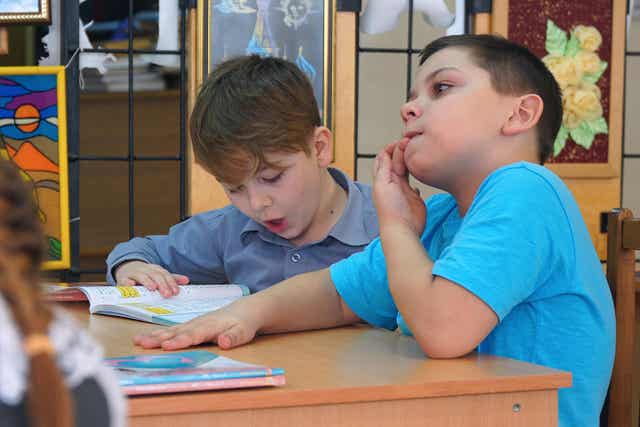Habit Reversal to Treat Nervous Tics in Kids


Written and verified by the psychologist Elena Sanz Martín
Nail biting, hair pulling, stuttering… There are many nervous tics that kids can have. At first, these seem harmless, but over time, they can increase and start to interfere with kids’ daily lives. Fortunately, we have proven procedures to address these types of problems, among which habit reversal stands out.
It’s common for parents to try to avoid the onset of tics by scolding or punishing their children. On the other hand, they may try to reward them if they stop doing it. However, none of these tactics will be effective since it’s not a voluntary act that the child can control.
So, with this strategy, parents can make sure to provide their kids with the tools they need to combat their nervous tics.

What are nervous tics?
Nervous tics are simple or complex behaviors that children perform repeatedly or involuntarily. These can be motor, like biting your fingers or rocking back and forth, or vocal, like constantly coughing or repeating the last word they heard.
They arise in response to a state of anxiety or nervousness that kids experience, and they disappear during sleep. These nervous tics are preceded by an internal feeling of restlessness, nervousness, and discomfort that’s only relieved with the repetition of the behavior. Therefore, it’s really hard to resist the impulse.
In addition, over time, they become a habit and no longer only appear when anxious, but in moments of frustration or boredom as well.
What is habit reversal?
Habit reversal is the most effective procedure for treating nervous tics in children. It includes a series of techniques and exercises that help kids stop the habit that interferes in their life.
Definition and registration
First of all, we need to define, in a concrete and operational way, what the nervous tics consist of. Likewise, you need to keep track of how often they happen and what situations cause them. To do this, an adult must observe the child and note when the tics happen.
Relaxation
If we take into account that the tic arises from the child’s internal feelings of anxiety and restlessness, it’s easy to understand why relaxation techniques are very helpful. By training the child in these strategies, you’re giving them a tool that will allow them to reduce their general anxiety level, as well as regulate their nervousness in certain situations.
Incompatible reaction: The key to habit reversal
This is the key to this intervention. You need to select a behavior that’s incompatible with the nervous tic itself that kids can do whenever they want to perform this tic. For example, holding a pen in their hand for a few minutes will help prevent the temptation to scratch their scalp.
The child should practice this several times every day until it feels natural to them. Then, they have to voluntarily put it into practice whenever they feel the tic coming on in order to stop them from doing it.
Positive reinforcement
It’s important to reward your child for the effort they make, even before completely getting rid of this disorder. So, make weekly goals, like cutting the frequency of the tic in half. Then, if they meet the goal, reward the child with praise and congratulations or even with a small material prize to keep motivating them.

Why does habit reversal work?
Habit reversal is a procedure that requires practice and perseverance. However, it’s simple and effective. The key to its success lies in two things.
First, it makes the child aware of their nervous tic in every situation. This is no longer an automatic reaction that goes unnoticed. At the same time, it provides an incompatible behavior that stops the tic from repeating itself, so the tic reduces in frequency until it goes away completely.
In short, researchers have proved its effectiveness in children with all kinds of nervous habits, and it’s shown good results. The child’s motivation and the help of parents and teachers will help reduce or eradicate these tics that make the child uncomfortable.
Nail biting, hair pulling, stuttering… There are many nervous tics that kids can have. At first, these seem harmless, but over time, they can increase and start to interfere with kids’ daily lives. Fortunately, we have proven procedures to address these types of problems, among which habit reversal stands out.
It’s common for parents to try to avoid the onset of tics by scolding or punishing their children. On the other hand, they may try to reward them if they stop doing it. However, none of these tactics will be effective since it’s not a voluntary act that the child can control.
So, with this strategy, parents can make sure to provide their kids with the tools they need to combat their nervous tics.

What are nervous tics?
Nervous tics are simple or complex behaviors that children perform repeatedly or involuntarily. These can be motor, like biting your fingers or rocking back and forth, or vocal, like constantly coughing or repeating the last word they heard.
They arise in response to a state of anxiety or nervousness that kids experience, and they disappear during sleep. These nervous tics are preceded by an internal feeling of restlessness, nervousness, and discomfort that’s only relieved with the repetition of the behavior. Therefore, it’s really hard to resist the impulse.
In addition, over time, they become a habit and no longer only appear when anxious, but in moments of frustration or boredom as well.
What is habit reversal?
Habit reversal is the most effective procedure for treating nervous tics in children. It includes a series of techniques and exercises that help kids stop the habit that interferes in their life.
Definition and registration
First of all, we need to define, in a concrete and operational way, what the nervous tics consist of. Likewise, you need to keep track of how often they happen and what situations cause them. To do this, an adult must observe the child and note when the tics happen.
Relaxation
If we take into account that the tic arises from the child’s internal feelings of anxiety and restlessness, it’s easy to understand why relaxation techniques are very helpful. By training the child in these strategies, you’re giving them a tool that will allow them to reduce their general anxiety level, as well as regulate their nervousness in certain situations.
Incompatible reaction: The key to habit reversal
This is the key to this intervention. You need to select a behavior that’s incompatible with the nervous tic itself that kids can do whenever they want to perform this tic. For example, holding a pen in their hand for a few minutes will help prevent the temptation to scratch their scalp.
The child should practice this several times every day until it feels natural to them. Then, they have to voluntarily put it into practice whenever they feel the tic coming on in order to stop them from doing it.
Positive reinforcement
It’s important to reward your child for the effort they make, even before completely getting rid of this disorder. So, make weekly goals, like cutting the frequency of the tic in half. Then, if they meet the goal, reward the child with praise and congratulations or even with a small material prize to keep motivating them.

Why does habit reversal work?
Habit reversal is a procedure that requires practice and perseverance. However, it’s simple and effective. The key to its success lies in two things.
First, it makes the child aware of their nervous tic in every situation. This is no longer an automatic reaction that goes unnoticed. At the same time, it provides an incompatible behavior that stops the tic from repeating itself, so the tic reduces in frequency until it goes away completely.
In short, researchers have proved its effectiveness in children with all kinds of nervous habits, and it’s shown good results. The child’s motivation and the help of parents and teachers will help reduce or eradicate these tics that make the child uncomfortable.
All cited sources were thoroughly reviewed by our team to ensure their quality, reliability, currency, and validity. The bibliography of this article was considered reliable and of academic or scientific accuracy.
- Calderón, M. J. G., & Ayensa, J. I. B. USOS TERAPÉUTICOS DE LA TÉCNICA DE INVERSIÓN DE HÁBITO: UNA REVISIÓN. http://www.tricotilomania.org/paneldecontrol/noticias/archivos/Inversion%20del%20Habito.pdf
- Ladouceur, R. (1979). Habit reversal treatment: learning an incompatible response or increasing the subject’s awareness?. Behaviour Research and Therapy, 17(4), 313-316. https://www.sciencedirect.com/science/article/abs/pii/0005796779900032
This text is provided for informational purposes only and does not replace consultation with a professional. If in doubt, consult your specialist.








